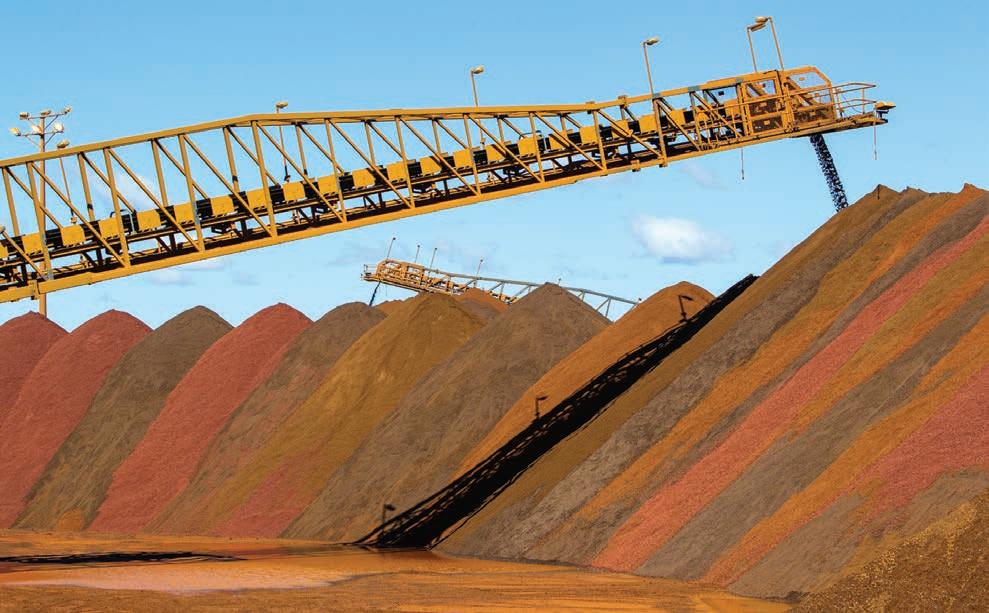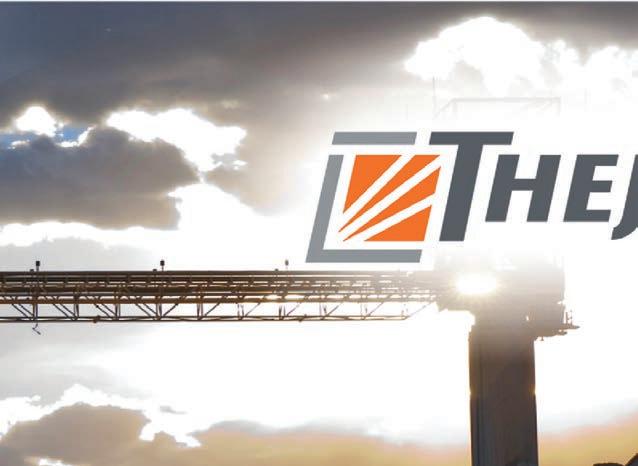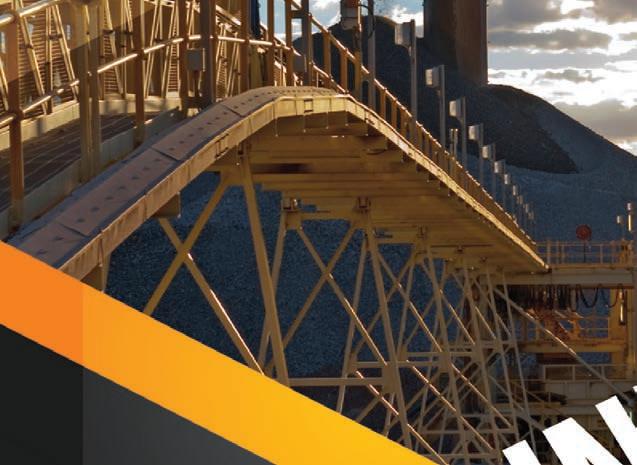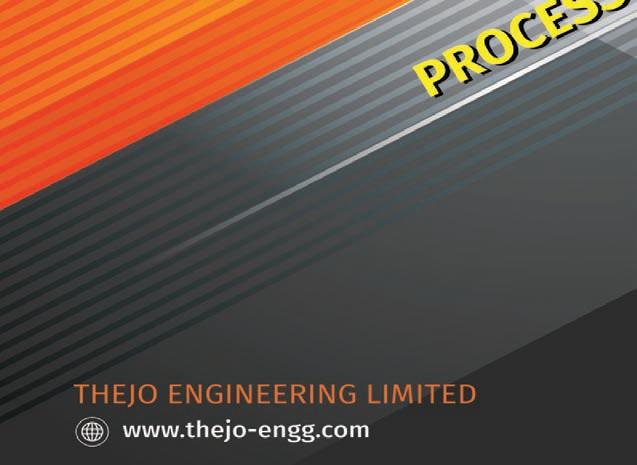
25 minute read
COMMENT
PAUL HAYES
paul.hayes@primecreative.com.au
SEPARATING THE GOOD FROM THE NOT AS GOOD
IT SEEMS AN OBVIOUS THING TO SAY, BUT MINING IS A MANY-TIERED PROCESS. EXTRACTING THE PRECIOUS METALS AND ORES FROM THE GROUND IS JUST ONE STEP IN THE MINING VALUE CHAIN.
From production to crushing and screening to mineral transportation and beyond, the mining industry embodies an expansive journey involving a seemingly endless series of people, equipment and expertise.
A critical cog in this cycle is mineral processing. Whatever’s extracted from the ground doesn’t become what it needs to be on its own, and without processing and beneficiation all that digging would be wasted time.
That’s why this issue of Australian Mining is shining a light on mineral processing, looking at some of the evolving methods, new technologies and developing equipment that are advancing this vital aspect of the industry.
We examine innovative and improved equipment like apron feeders and vibrating screens, new products that can help keep processing equipment in the best possible condition for a long on-site life, and new technologies such as automation that can help to make material characterisation safer and more efficient than ever before.
Elsewhere in this issue, environmental, social and governance (ESG) practices take centre stage in the first of a three-part Australian Mining series breaking down Deloitte’s Tracking the Trends 2022 report.
The first instalment examines how miners can utilise ESG as a means to create value in the resources sector, with leading experts providing their thoughts on key areas.
But it’s also important to remember that ESG not limited to ‘environmental’, and that is something Kal Tire has really wrapped its arms around.
The tyre services company’s managing director discusses how the organisation is constantly taking steps in developing its social and governance practices to create a safe and appealing workplace.
Looking at some commodities, increased activity in Queensland’s Bowen Basin shows there is definitely plenty of life left Australian coal, the chief executive officer of Liontown Resources explains how the company is setting itself up to be a big lithium player with the Tier 1 potential of its Kathleen Valley project, and we ask the question: is Australia about to go platinum?
As the COVID pandemic starts to (somewhat) recede and restrictions are wound back in many parts of the country, in-person events are back on the agenda – and the 2022 Women in Industry Awards taking place in April are a perfect example.
Ahead of the presentation, we speak to several of the finalists, each of whom represents some of the outstanding success achieved by women in traditionally maledominated industries, including mining, road transport, manufacturing, engineering, logistics, bulk handling, waste management, rail and infrastructure.
And, as usual, we cover the latest mining equipment and technology in our products section.
Paul Hayes Editor
FRONT COVER
Over the last few years, First Quantum Minerals Limited has commissioned some of the largest mineral processing equipment ever built. To help increase production at its Cobre Panama mine from 85Mtpa to 100Mtpa, the company engaged vibrating equipment specialist Schenck Process to deliver three of the largest banana scalping screens ever produced. These 85-tonne machines were designed and built at Schenck Process’ production facility in WA and will handle 8000tph. This month’s cover image shows the first of these ‘mega’ screens being lifted onto its isolation frame in preparation for testing.
Cover image: Schenck Process
CHIEF EXECUTIVE OFFICER JOHN MURPHY
PUBLISHER CHRISTINE CLANCY
EDITOR PAUL HAYES Email: paul.hayes@primecreative.com.au
ASSISTANT EDITOR MICHAEL PHILIPPS Email: michael.philipps@primecreative.com.au
JOURNALISTS EMILY MURPHY Email: emily.murphy@primecreative.com.au HENRY BALLARD Email: henry.ballard@primecreative.com.au
CLIENT SUCCESS MANAGER JANINE CLEMENTS Tel: (02) 9439 7227 Email: janine.clements@primecreative.com.au
SALES MANAGER JONATHAN DUCKETT Tel: (02) 9439 7227 Mob: 0498 091 027 Email: jonathan.duckett@primecreative.com.au
SALES ADMINISTRATOR EMMA JAMES Tel: (02) 9439 7227 Mob: 0414 217 190 Email: emma.james@primecreative.com.au ART DIRECTOR BLAKE STOREY blake.storey@primecreative.com.au
GRAPHIC DESIGNERS KERRY PERT, AISLING MCCOMISKEY
SUBSCRIPTION RATES Australia (surface mail) $120.00 (incl GST) Overseas A$149.00
For subscriptions enquiries please contact (03) 9690 8766 subscriptions@primecreative.com.au
PRIME CREATIVE MEDIA Suite 303, 1-9 Chandos Street Saint Leonards NSW 2065, Australia www.primecreative.com.au © Copyright Prime Creative Media, 2016 All rights reserved. No part of the publication may be reproduced or copied in any form or by any means without the written permission of the publisher.
PRINTED BY MANARK PRINTING 28 Dingley Ave Dandenong VIC 3175 Ph: (03) 9794 8337 Published 12 issues a year
THE LATEST MINING AND SAFETY NEWS
AUSTRALIAN MINING PRESENTS THE LATEST NEWS FROM THE BOARDROOM TO THE MINE AND EVERYWHERE IN BETWEEN. VISIT WWW.AUSTRALIANMINING.COM.AU TO KEEP UP TO DATE WITH WHAT IS HAPPENING.
BHP GETS IRON ORE VESSEL MOVING
BHP’s world-first LNG-fuelled Newcastlemax bulk carrier has set sail between WA and Asia. On its maiden voyage, MV Mount Tourmaline arrived at Jurong Port in Singapore for its first liquefied natural gas (LNG) bunkering operation, taking place through the FueLNG Bellina, the first LNG bunker vessel in Singapore.
FueLNG, a joint venture between Shell Eastern Petroleum and Keppel Offshore & Marine, operates the bunker vessel.
BHP awarded Eastern Pacific Shipping (EPS) a five-year contract for five LNG-fuelled Newcastlemax bulk carriers in September 2020, and awarded the LNG fuel contract to Shell in December 2020
“These dual-fuel LNG Newcastlemax vessels are a world’s first, but more importantly, they represent a culture shift in shipping and mining,” EPS chief executive officer Cyril Ducau said.
“These ships tell both industries that significant carbon-emission reduction is available today and necessary to implement, as we work towards net-zero solutions. EPS would like to congratulate BHP, FueLNG, MPA, and Shell for being leaders in the decarbonisation movement.”
After LNG bunkering, the 209,000-deadweight tonne vessel will leave for Port Hedland in WA for iron ore loading operations.
“BHP works with our suppliers to embed innovative and sustainable solutions in our supply chain,” BHP chief commercial officer Vandita Pant said.
“This vessel delivers significant improvements to energy efficiency and emissions intensity, as well as reduced overall GHG emissions in our value chain.
“These LNG-fuelled vessels are expected to reduce GHG (greenhouse gas) emissions intensity by more than 30 per cent on a per-voyage basis compared to a conventional fuelled voyage and will contribute towards our 2030 goal to support 40 per cent emissions intensity reduction of BHP-chartered shipping of our products.”
THE LNG-FUELLED NEWCASTLEMAX BULK CARRIER MOUNT TOURMALINE AUSTRALIAN MINING GETS THE LATEST NEWS EVERY DAY, PROVIDING MINING PROFESSIONALS WITH UP-TOTHE-MINUTE INFORMATION ON SAFETY, NEWS AND TECHNOLOGY FOR THE AUSTRALIAN MINING AND RESOURCES INDUSTRY.

GOLDING AND SIMEC AGREE TO $600M DEAL
NRW Holdings’ wholly-owned subsidiary Golding Contractors has signed a three-year contract extension worth approximately $600 million with OneSteel Manufacturing trading as SIMEC Mining.
The mining services agreement will be extended until January 31, 2025, with an option for SIMEC to extend the contract for a further three years.
“This extended agreement is particularly pleasing as an example of a Golding team working closely with our client to generate sustained cost-effective solutions,” NRW chief executive officer and managing director Jules Pemberton said.
Golding will continue to provide mine planning, load and haul, and maintenance services at the South Middleback Ranges and Iron Baron mining area in South Australia, as well as the recommencement of a third mining area at Iron Knob.
The 10 million tonne-perannum iron ore mine in the Middleback Ranges is owned by SIMEC, which mines both hematite and magnetite iron ore.
Total reserves and resources come in at just under half a billion tonnes.
Golding will also employ approximately 600 people at the mines, most of whom live in the Whyalla district of South Australia or in the Adelaide region.
NRW is a leading provider of diversified contract services to the resources and infrastructure sectors in Australia.
These services encompass civil construction, including bulk earthworks, road and rail construction, and concrete installation, together with contract mining and drill and blast services through NRW Civil & Mining, Golding Contractors and Action Drill & Blast.
Golding delivers a full range of open-cut mining services in the mining sector, spanning the entire mine development and operations.
Golding also offers specialist mine site rehabilitation works, including environmental dam construction and reclamation earthworks.
FORTESCUE PLANS UNRIVALLED RENEWABLES HUB
THE HUB WILL BE SUFFICIENT FOR POWERING FORTESCUE’S PILBARA MINING OPERATIONS.
Fortescue Metals Group (FMG) has proposed to construct a 5.4 gigawatt (GW) renewable energy hub in the Pilbara region of Western Australia to fulfil its net-zero promise by 2030.
Fortescue subsidiary Pilbara Energy submitted a proposal for the Uaroo Renewable Energy Hub to the state’s Environmental Protection Authority (EPA), asking for a development area of 61,525 hectares.
The project would be located 120 kilometres south of Onslow and 170 kilometres west of Fortescue’s Eliwana iron ore mine.
The project would include up to 340 wind turbines, a solar farm and a battery energy storage system with associated infrastructure.
A temporary construction camp would also be included with a capacity of 1600 people, while the hub’s operational workforce would include up to 100 people.
Construction of the Uaroo Renewable Energy Hub is hoped to be complete over a seven-year timeframe once the appropriate approvals are received.
The proposal said the hub would be sufficient for powering Fortescue’s Pilbara mining operations,regardless of the weather conditions.
“The proposal has been scaled to supply FMG mining operations and with consideration for the intermittency of wind and solar power generation – that is, the variability of wind speed and the restriction of solar power generation to daylight hours,” the proposal stated,
The wind turbines are expected to generate peak power around 40 per cent of the time and the solar farm for 30 per cent.
This will allow Fortescue to reduce scope 1 and 2 emissions from its mining operations by at least 1.5 million tonnes of carbon emissions or equivalents each year – displacing diesel and gas-fired power.
Fortescue’s proposal hoped this plan would inspire others to implement similar solutions, as they too target net-zero operations.
“The proposal will demonstrate the viability of zero-carbon technologies in fuelling commercialscale operations and will encourage other proponents to follow suit,” it stated.

THIESS LOCKS IN $1.5B AT OLIVE DOWNS
Pembroke Resources has awarded Thiess a contract for the provision of mining services at its Olive Downs coking coal complex in Queensland’s Bowen Basin.
The eight-year contract is expected to produce $1.5 billion in revenue for Thiess over the first five years, with revenue beyond this term to be finalised.
“We’re pleased to be working in partnership with Pembroke, tailoring our mine development capability, technology focus and ESG (environmental, social and governance) credentials to optimise the outcomes for the production of steelmaking coal from Olive Downs,” Thiess executive chairman and chief executive officer Michael Wright said.
“Pembroke and Thiess share a view of Olive Downs being a world-class mine that sets global benchmarks in sustainable mining, using technology to drive exceptional outcomes.”
Thiess will deliver full-service mining operations, including mine planning, overburden removal, drill and blast, load and haul, water management and rehabilitation of final landforms at Olive Downs.
This includes the construction of mine infrastructure, providing all mobile plant and equipment, as well as the statutory operator for the project.
Thiess executive general manager Australia Shaun Newberry said the company was well placed to best serve Pembroke, using its intimate knowledge of the region.
“We have a long history operating in the Bowen Basin, applying our technical knowledge and operational experience to minimise environmental impacts and maximise benefits for our client and the community,” Newberry said.
“We look forward to working with Pembroke and surrounding communities to achieve long-term social, environmental and economic outcomes.”
This announcement follows two mining services worth $200 million that were awarded to Thiess in December 2021 from BHP Mitsubishi Alliance and Austral Resources.
Thiess will commence operations at Olive Downs in the first half of 2023, subject to the finalisation of contracts.
IRON ORE SETS NEW EXPORT REVENUE RECORD
Australian resources export revenue reached a new record high of $351 billion in 2021, according to the latest data from the Australian Bureau of Statistics.
The record shows a 21 per cent increase from the previous high set in 2019, with resources contributing 68 per cent of total Australian export revenue.
Iron ore was the highest contributing resource with $154.2 billion, up 32 per cent from 2020, to set a record high. Coal contributed $62 billion, up 43 per cent from 2020, with aluminium (including alumina and bauxite) adding $13.7 billion, up 15 per cent from 2020.
Copper (metal and concentrates) added $12.1 billion, up 14 per cent from 2020 and a new record high, while gold contributed $25.9 billion.
Federal Minister for Resources and Water Keith Pitt said the latest monthly figures showed Australia’s resource and energy exports continue to surge in record territory.
“It is important to thank the men and women in our resources and energy sector for their stellar work in ensuring our valuable commodities are meeting global demand,” Pitt said. “These export earnings continue to create and sustain jobs for Australians, particularly in regional areas.
“Resources remain far and away Australia’s biggest export earner and continue to underpin the strength of the national economy.
“The outlook for our resources and energy sector continues to be positive as global demand for Australian resources remains strong, particularly for our coal and gas.”
Minerals Council of Australia chief executive officer Tania Constable said the record growth demonstrated the importance of the mining industry to Australia’s economy.
“This incredible growth in revenue has also delivered Australia its largest ever trade surplus ($123 billion) during the COVID-19 pandemic, at a time when it needed economic stimulus the most,” Constable said.
“Ongoing demand for resources is driving the 258,000 direct mining jobs, with significant benefits flowing to all of Australia and particularly regional communities.
“Australia is proving again how its highly-skilled, innovative mining workforce is competitively supplying the minerals for the future.”
However, Constable added it was important not to take the positive trade figures for granted.
“More must be done to attract the investment needed for new projects in Australia to meet growing world demand for minerals for everyday living and to drive the energy transition to net zero emissions,” she said.
“Over a decade ago, the investment phase of the mining boom underpinned the nation’s rebound from the Global Financial Crisis with over $370 billion spent in the five years to 2014 developing new resources projects and building critical infrastructure in regional areas.”
Constable said while Australia had significant endowments of copper, lithium, nickel, gold and rare earth elements, it is important to note that developing these deposits into the mines of the future is far from guaranteed.
“Globally competitive tax rates, more workplace flexibility and increased government funding for pre-competitive exploration programs are all essential to mining’s longterm future and Australia’s economic prosperity,” she said.
“And when the mining industry is strong, all Australians benefit.”

IRON ORE WAS THE HIGHEST CONTRIBUTING RESOURCE WITH $154.2 BILLION.
MONADELPHOUS’ $400M CONTRACTS COVER ALL BASES
Monadelphous has revealed a basket of new contracts in the resources and energy sectors worth about $400 million, including with South32, Newcrest and Codelco.
The engineering company received a 12-month extension to its supply of shutdown and major mechanical services at South32’s Worsley alumina refinery in Collie, Western Australia, where it has worked since 2015.
Newcrest awarded a contract for structural, mechanical, piping and electrical works on the Lihir gold mine front-end recovery project in Papua New Guinea.
Monadelphous managing director Rob Velletri said he was proud of the company’s ability to maintain a strong reputation across sectors and with various clients.
“We are pleased to continue our long-standing relationships with these valued customers and are committed to continuing the provision of high-quality, innovative and safe solutions,” he said.
In Chile, Monadelphous subsidiary Buildtek will provide mine infrastructure maintenance and repairs at the Chuqicamata underground copper mine for three years. It will also maintain the heap leaching process and electrowinning copper extraction plant at the Radomiro Tomic copper mine for five years.
Also in Chile, Buildtek was awarded a contract by Collahuasi Mining Company, owned by Anglo American, Glencore and Japan Collahuasi Resources.
Buildtek will provide modifications to the concentrate distribution system at the Collahuasi Maritime Terminal.
In the energy sector, Monadelphous also won a $150 million contract extension with Woodside Energy to provide maintenance, shutdown and brownfields project services at Woodside’s onshore and offshore gas production facilities in Western Australia
The contract basket follows a strong 2021 for Monadelphous which saw the company end the year with about 7800 people in its workforce – up around 37 per cent on the previous year.
In 2021, the company’s engineering construction division achieved its highest revenue since 2015, securing new contracts worth about $620 million, including $200 million after June 30.
RIO TINTO RAMPS UP TASSIE RENEWABLES


Rio Tinto has partnered with the Tasmanian Government to investigate the development of new industries and boost the resources sector’s contribution to the state’s economy.
A Memorandum of understanding (MoU) will see Rio and the State Government attempt to decarbonise the Bell Bay aluminium smelter and allow it to feed clean technology industries that require vast amounts of aluminium.
Aluminium is used in a majority of the photovoltaic (PV) components in solar panels, most notably in the frames that hold them together.
By decarbonising Bell Bay, which produces 192,000 tonnes of aluminium per year, Rio can aid in the uptake of solar power globally.
Tasmanian Premier Peter Gutwein said both MoU parties recognised the important relationship between Tasmania and the resources sector.
“This MoU is a strong demonstration of our shared commitment to Tasmania’s economic and industrial future and reinforces the state’s renewable energy credentials,” Gutwein said.
“Rio Tinto has been a figurehead of local industry here for some 67 years, directly employing more than 500 Tasmanians and more than 700 indirectly, and this agreement reaffirms Rio Tinto’s long-term commitment to our state.”
In January, Tasmania recorded a fourth consecutive month where the annualised export figures exceeded $4 billion, with 64.1 per cent coming from non-ferrous metals, metallic ores and metal scraps.


RIO TINTO AND THE TASMANIAN GOVERNMENT WILL ATTEMPT TO DECARBONISE THE BELL BAY ALUMINIUM SMELTER.
“These strong results follow data released showing that Tasmania has the fastest growing economy in the nation, with State Final Demand growing 4.2 per cent in the September 2021 quarter,” Tasmanian Trade Minister Guy Barnett said last year.
The Bell Bay aluminium smelter has continued to play its part in, having operated in Tasmania since 1955, making it the oldest aluminium smelter in the southern hemisphere.
Rio Tinto chief executive officer Jakob Stausholm recognised the importance of aluminium in decarbonising efforts.
“Aluminium is essential for the global transition to a low-carbon economy and we are excited about the contribution our Bell Bay smelter can make both towards this transition and to the region’s future,” Stausholm said.
“We want to help ensure a strong and vibrant future for Bell Bay, where we have been part of the community for well over half a century and where we are actively working with the Tasmanian Government on a shared vision for the future.”
OZ LINES UP WEST MUSGRAVE WITH EPA APPROVAL
OZ Minerals has received Environmental Protection Authority (EPA) approval for its West Musgrave copper-nickel mines in Western Australia, as the company approaches a final investment decision.
The project proposed to develop two deposits (Babel and Nebo) near the intersection of Western Australia, South Australia and the Northern Territory, 1300 kilometres north-east of Perth.
The operation would have a mine life of 26 years as OZ Minerals seeks to produce about 26,000 tonnes per nickel and 32,000 tonnes of copper per year.
In the company’s quarterly report for December 2021, managing director and chief executive officer Andrew Cole said the project was increasing in cost as OZ targeted a final investment decision.
“The West Musgrave study progressed well during the year, with many aspects of the project well advanced and technically de-risked. The team continues to work through a range of value opportunities for inclusion into the project base case, albeit we are also seeing capital escalation in a number of areas, with full costings yet to be concluded,” Cole said.
“The project remains on track for a final investment decision in H2 2022; however, uncertainties also remain in relation to ongoing border restrictions, labour availability and the potential impact on project schedule and costs.”
The EPA recommended development of up to 20,852 hectares (ha) with no more than 3830ha of native vegetation cleared.
The recommendation also stated 1.465 billion tonnes of waste rock was suitable for permanent waste rock dumps and a tailings storage facility (or Nebo pit void) would need to contain up to 315 million tonnes (Mt) of tailings.
The project is proposed to be powered by a range of renewable energy sources, as OZ Minerals attempts to operate the site with net-zero emissions by 2040.
With no emissions mitigation measures, the project would produce about 9.48Mt of Scope 1 carbon emissions over its 26-year life. This is equivalent to 364,675 tonnes per year.
With the proposed mitigation measures of wind turbines, solar power and a battery energy storage system, plus a greenhouse gas management plan, the project will begin operating at 196,500 tonnes of Scope 1 emissions per annum – almost halving the potential for Scope 1 emissions.
From 2033, the project will not produce more than 75,000 tonnes of carbon emissions per year, with carbon neutrality projected for 2040.








SANDVIK CLOSING IN ON ANOTHER WORLD-FIRST
THE TH655B IS EXPECTED TO BE 30 PER CENT FASTER ON A 1:7 RAMP THAN A COMPARABLE DIESEL TRUCK.
Sandvik has almost completed testing the largest battery-electric underground mining truck for use at AngloGold Ashanti’s Sunrise Dam gold mine in Western Australia.
The 65-tonne TH655B prototype will be trialled at Sunrise Dam under an agreement with Barminco and AngloGold Ashanti, before expected commercial production in late-2023.
Sandvik mining and rock solutions president Henrik Ager said this was the natural progression for Sandvik equipment.
“With more than 50 years’ experience in the design and manufacture of underground mining equipment, we’re proud to continue to lead the way in helping customers embrace more sustainable solutions,” Ager said.
“Our 65-tonne battery-electric truck is our latest development in helping mass hard rock miners and contractors to make the shift towards more productive, emissionfree mining.”
The TH655B is expected to be 30 per cent faster on a 1:7 ramp than a comparable diesel truck with an electric drivetrain output of 640kW.
The machine follows Sandvik’s introduction of the TH550B 50-tonne BEV, which was unveiled at MINExpo in Las Vegas last September.
The new TH655B takes a similar cabin design as that from the Toro TH663i underground truck, equipped with joystick steering, large touchscreen and new control system for enhanced ergonomics.
This prototype won’t be the first time Sandvik and Barminco have been involved in a world-first, either.
In September 2019, Barminco received the world’s first mobile raise boring machine with back reaming capability – a bespoke edition of Sandvik’s Rhino 100 mobile raise boring machine.
The machine was also deployed at Sunrise Dam and was able to be set up for operation within two hours, instead of the usual three to four days for a conventional machine.

GLENCORE ONE STEP CLOSER TO GLENDELL EXTE
Glencore has received New South Wales Department of Planning, Industry and the Environment (DPIE) approval for its Glendell Continued Operations project located in the Upper Hunter Valley of New South Wales.
A final determination on the project will now be made by the NSW Independent Planning Commission (IPC) following its assessment process that will include a public hearing.
The Glendell open-cut coal mine is part of Glencore Coal’s Mount Owen complex at Ravensworth.
The complex contains the Mt Owen, Ravensworth East and Glendell mines, with the integration of these operations enabling all sites to use a single coal handling and preparation plant (CHPP) as well as infrastructure at the Mt Owen mine.
The Glendell project proposes to continue mining for a further 21 years beyond current approvals to around 2044 on land almost completely owned by Glencore.
The project involves extending the life of the existing operations by establishing a new mining area, the Glendell pit extension, to the north of the current Glendell pit.
Development of the Glendell pit extension would enable the extraction of an additional 135 million tonnes (Mt) of run-of-mine (ROM) coal over the 21 years, at an increased production rate of up to 10 million tonnes per annum.
The project will provide employment opportunities for up to 690 personnel and create a further 350 construction jobs.
Glencore has invested more than $15 million in developing the project, and over the past five years has engaged with a wide range of stakeholders on different aspects of the project, including Singleton Council, government agencies, Registered Aboriginal Parties, near neighbours, and the communities of Singleton and Broke.
It will also add $282 million in royalties that help the NSW Government continue to pay the wages of nurses, teachers and police, and to build muchneeded infrastructure.
Public submissions in support of the project commented on the economic benefits, including employment generation and the payment of royalties to the NSW Government, as well as the positive social impacts, noting Glencore’s support for local businesses and community organisations.
Those opposed to the project were primarily concerned with the potential impacts on air quality, water resources and amenity impacts, along with broader commentary about the mining industry’s impact on climate change.
The DPIE concluded that Glencore designed the project in a manner that achieves a good balance between maximising the recovery of a coal resource of state significance and minimising the potential environmental impacts.
ILUKA REFINERY TO LEAD THE WESTERN WORLD
Iluka Resources has made promising progress towards developing a rare earths refinery in Eneabba, Western Australia, with a government-backed feasibility study expected to be finalised in March.
The company has been stockpiling rare earths monazite and xenotime at a former mining void in Eneabba since the early 1990s and is now working through phase three of a fully integrated refinery.
Phase one began in 2020 when a mixed monazite-zircon concentrate was produced, before phase two construction began in 2021.
This construction is expected to be commissioned in the first half of 2022, as the feasibility study for the refinery’s full integration is completed.
In Iluka’s half-year report, ending December 31 2021, the company emphasised the magnitude of owning such a facility.
“If it existed today, Eneabba phase three would be the only operational refinery of its type in the Western world,” the company stated.
“Phase three presents an opportunity to establish a strategic processing hub for the further growth of Australia’s rare earths refinery.”
The industry is indeed growing. Hastings Technology Metals’ Yangibana rare earths project in Western Australia has been recognised by the State Government with a commendation from Premier Mark McGowan.
More recently, Hastings received multiple approvals for Yangibana and a $140 million loan from the government’s Northern Australia Infrastructure Facility (NAIF).
This kind of positivity has given Iluka managing director Tom O’Leary the confidence to proceed with the Eneabba project.
“Iluka is in discussions with the Australian Government regarding risk-sharing arrangements for a potential phase three at Eneabba,” O’Leary said in the half-year report.
“Growing demand for rare earths in 2021 was reflected in rising prices throughout the year.
“This demand is project to increase markedly in coming years.”
ILUKA HAS BEEN STOCKPILING RARE EARTHS AT A FORMER MINING VOID IN ENEABBA SINCE THE EARLY 1990S.
BHP SHIPS DIRECT TO PILBARA

BHP will increase the direct shipping of supplies from Singapore to Port Hedland, providing local business opportunities for Western Australia’s Pilbara region.
BHP has been trialling direct shipping to Port Hedland since 2020 and will now ship 7.5 per cent of the containerised supplies it receives into its Western Australian Iron Ore (WAIO) operations from all over the world through Singapore, directly to Port Hedland.
BHP’s WAIO general manager of port operations Cindy Dunham said since BHP began trialling the transport project, the business has seen safety, cost, efficiency, and environmental improvements.
“This initiative not only improves efficiency, it also improves safety and environmental outcomes, thereby benefiting the whole community,” Dunham said.
“BHP would like to work with local businesses in Port Hedland to explore opportunities to optimise their own supply chains via this shipping route.
“We are committed to helping develop Port Hedland as a thriving, sustainable place to live.”
Pilbara businesses will be able to benefit from the direct shipping route, through BHP’s freight provider ANL.
BHP plans to make this direct route open and available to businesses interested in reducing their transport costs for building supplies and consumer goods.
It is estimated that there will be a six-day reduction in transportation time, and the move will also reduce the greenhouse gas emissions related to the transportation of the re-routed goods into the Pilbara by up to 75 per cent per container.
Before the trial began, BHP supplies for WAIO were shipped to the Port of Fremantle and were then transported 1650 kilometres by road to Port Hedland.
Pilbara Ports Authority chief executive officer Roger Johnston said direct shipping in the Pilbara had grown faster than predicted since the first call in late2020, with benefits to the port, proponents, and the local economy already being realised.
“PPA is proud of the work it has done to make direct shipping possible and has already trebled its first port of entry facilities to accommodate growing demand,” Johnston said.
“The service is generating more inbound and outbound freight opportunities, which in turn creates local opportunities for container de-stuffing, warehousing, and distribution.
“A recent report by ACIL Allen estimates the economic benefit of near-port freight efficiencies to be approximately $5 million per annum, while imported cargo freight efficiencies are in the order of $60 million per annum.”










